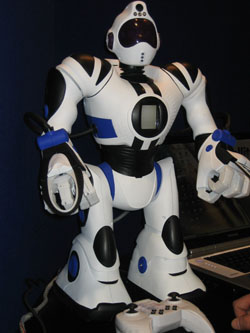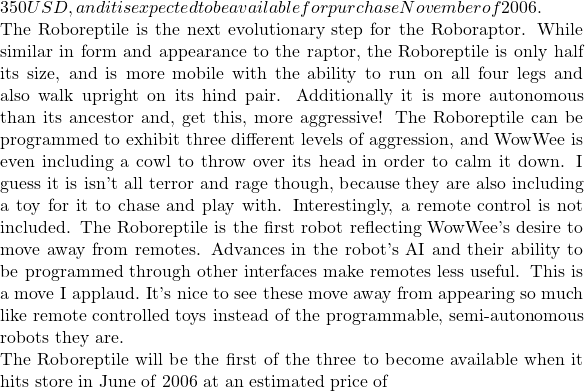
WowWee announced three new robots at the Consumer Electronics Expo (CES) in Las Vegas last week, and the guys from both Gizmodo and Engadget were able to swing by their booth at the Sands Convention Center to get firsthand glimpses of the new bots, and to provide for us, the unfortunate non-attendees, some great pictures. The Robosapien RS2 Media, the Roboreptile, and the P-Bot will become available commercially over the next year and a half and will join the other immensely popular robots manufactured by WowWee including the Robosapien, the Robosapien V2, the Roboraptor, and the Robopet.
The Robosapien RS2 Media is the latest in WowWee flagship Robosapien line. The original Robosapien was released in 2003 and has sold more than 2 million units. And even though the V2 is just now hitting store shelves, the RS2 Media is a serious upgrade to the family, offering multimedia capabilities for the first time and a significantly increased level of programmability. The key to many of the RS2’s new powers is an SD card slot built into its back. The card will be able to record the motion of the RS2’s limbs as well as voices through its built-in microphone. Then, with the bundled BodyCon Editor software users can combine everything together to create a “personality”. Because they are stored on removable media, users will be able to load in different custom personalities and even swap them with others.
The Media in RS2 Media is based in part on a new 320 x 160 color LCD in the robot’s chest that gives a live view of the what the RS2 sees through the camera in its head. Images and MPEG4 video can both be captured to the SD card, and played through the LCD. Other multimedia enhancements include built-in stereo speakers and subwoofer. In addition to the IR interface found on earlier models, the RS2 sports a USB 1.0 port, and like its forbearers, the RS2 will recognize voice and movement commands.
WowWee is estimating that the retail price for Robosapien RS2 Media will be  130 USD.
130 USD.
The Personality Bot, or P-Bot for short, is a very early prototype resulting from an alliance with Segway formed last year. Using the balancing technology found in the Segway Human Transporter, this two-wheeled robot is able to carry small objects on its back. Also unique to this model is the ability to upright itself if it should fall using its two wheel-tipped arms. The balancing system plays second fiddle to its programmable personality though. The P-Bot has an LCD screen for a face that reflects the current emotional state of the robot. It can chat and joke with users and even gets mad when it falls down. Like the Roboreptile, the P-Bot will not have a remote.
Retail details for the P-Bot are far from firm. It is expected to show up in stores very late this year or in early 2007 at a cost of at least $200 USD but probably more.
